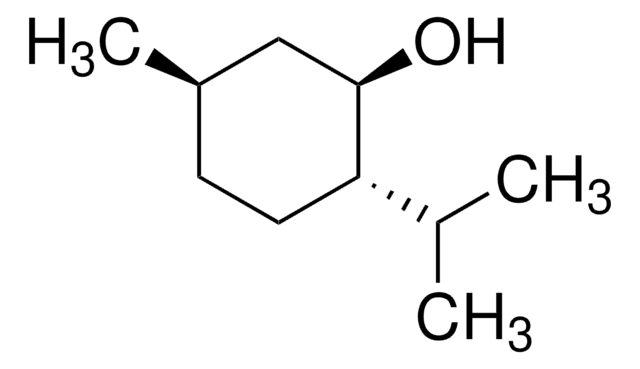W324507
Undecanoic acid
≥99%, FG
Sinonimo/i:
Hendecanoic acid
About This Item
Prodotti consigliati
Origine biologica
synthetic
Grado
FG
Fragrance grade
agenzia
follows IFRA guidelines
Conformità normativa
EU Regulation 1223/2009
EU Regulation 1334/2008 & 178/2002
FDA
Saggio
≥99%
P. eboll.
228 °C/160 mmHg (lit.)
248-250 °C (lit.)
Punto di fusione
28-31 °C (lit.)
applicazioni
flavors and fragrances
Documentazione
see Safety & Documentation for available documents
Allergene alimentare
no known allergens
Allergene in fragranze
no known allergens
Organolettico
creamy; waxy
Stringa SMILE
CCCCCCCCCCC(O)=O
InChI
1S/C11H22O2/c1-2-3-4-5-6-7-8-9-10-11(12)13/h2-10H2,1H3,(H,12,13)
ZDPHROOEEOARMN-UHFFFAOYSA-N
Cerchi prodotti simili? Visita Guida al confronto tra prodotti
Categorie correlate
Descrizione generale
Applicazioni
- Undecanoic Acid and L-Phenylalanine in Vermiculite: Detection, Characterization, and UV Degradation Studies for Biosignature Identification on Mars.: This research focuses on the detection and characterization of undecanoic acid and L-phenylalanine in vermiculite, with potential applications for biosignature identification on Mars. The study also examines UV degradation, which is crucial for astrobiological research (McIntosh et al., 2024).
- Drugs Form Ternary Complexes with Human Liver Fatty Acid Binding Protein 1 (FABP1) and FABP1 Binding Alters Drug Metabolism.: This paper explores how drugs interact with human liver fatty acid binding protein 1 (FABP1), including the involvement of undecanoic acid, to form ternary complexes that influence drug metabolism. These findings have significant implications for pharmacology and drug development (Yabut et al., 2024).
- Enhancing antifungal and biocompatible efficacy of undecanoic acid through incorporation with chitosan-based nanoemulsion.: This study demonstrates the enhanced antifungal and biocompatible properties of undecanoic acid when incorporated into a chitosan-based nanoemulsion, highlighting potential biomedical applications for this compound (Sathiyaseelan et al., 2024).
- In Vitro Evaluation of Essential Oils and Saturated Fatty Acids for Repellency against the Old-World Sand Fly, Phlebotomus papatasi (Scopoli) (Diptera: Psychodidae).: This research evaluates the repellency of essential oils and saturated fatty acids, including undecanoic acid, against the Old-World sand fly. The findings provide insights into developing natural repellents for vector control (Temeyer et al., 2024).
Codice della classe di stoccaggio
11 - Combustible Solids
Classe di pericolosità dell'acqua (WGK)
WGK 1
Punto d’infiammabilità (°F)
>233.6 °F
Punto d’infiammabilità (°C)
> 112 °C
Dispositivi di protezione individuale
dust mask type N95 (US), Eyeshields, Gloves
Scegli una delle versioni più recenti:
Possiedi già questo prodotto?
I documenti relativi ai prodotti acquistati recentemente sono disponibili nell’Archivio dei documenti.
I clienti hanno visto anche
Il team dei nostri ricercatori vanta grande esperienza in tutte le aree della ricerca quali Life Science, scienza dei materiali, sintesi chimica, cromatografia, discipline analitiche, ecc..
Contatta l'Assistenza Tecnica.








